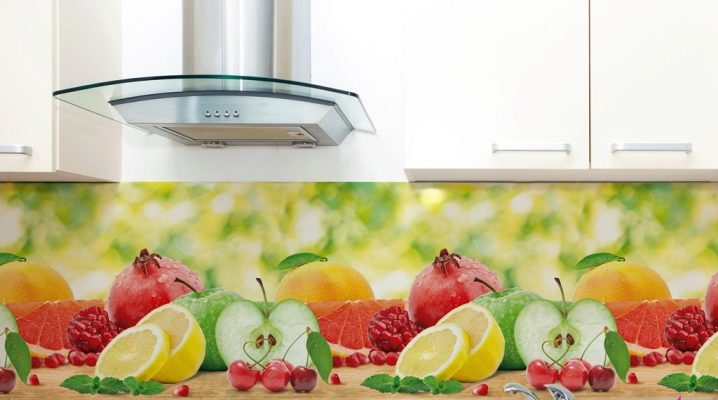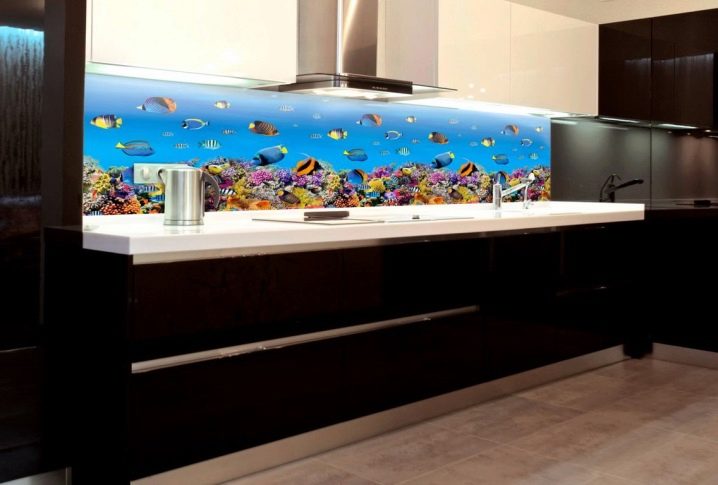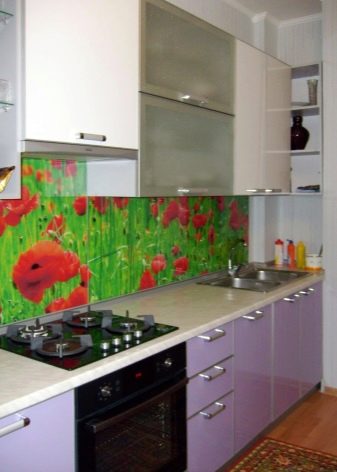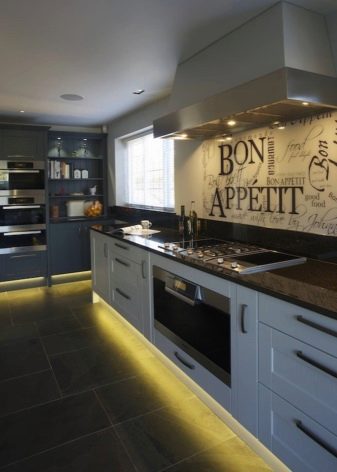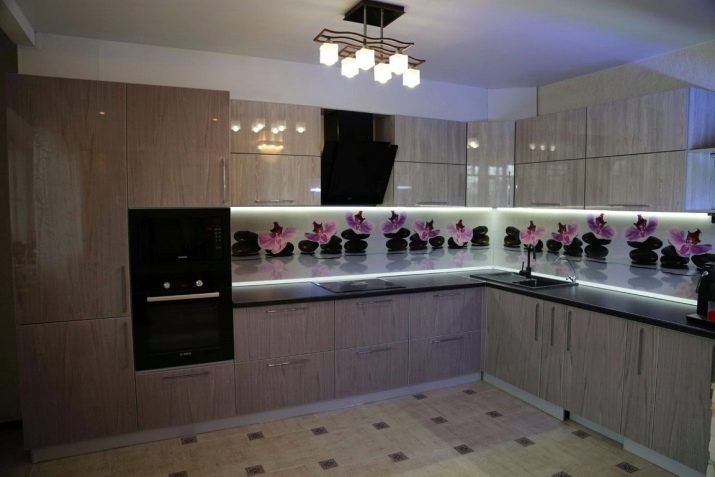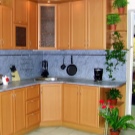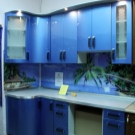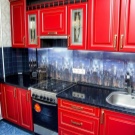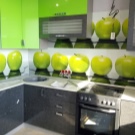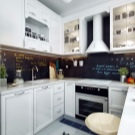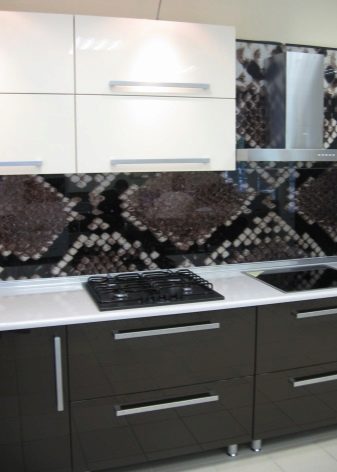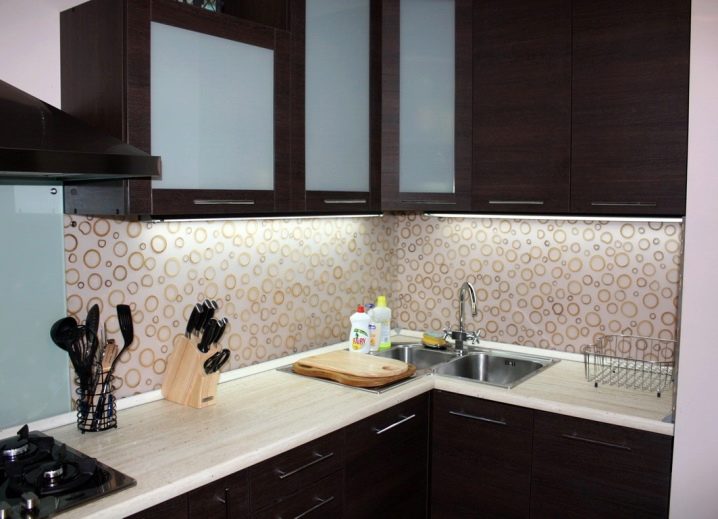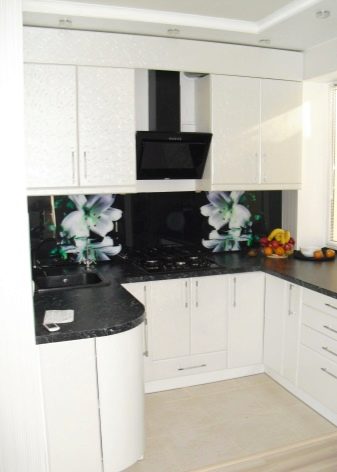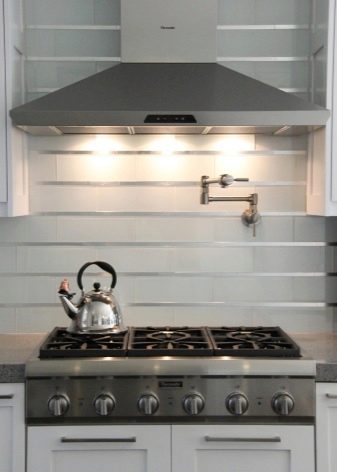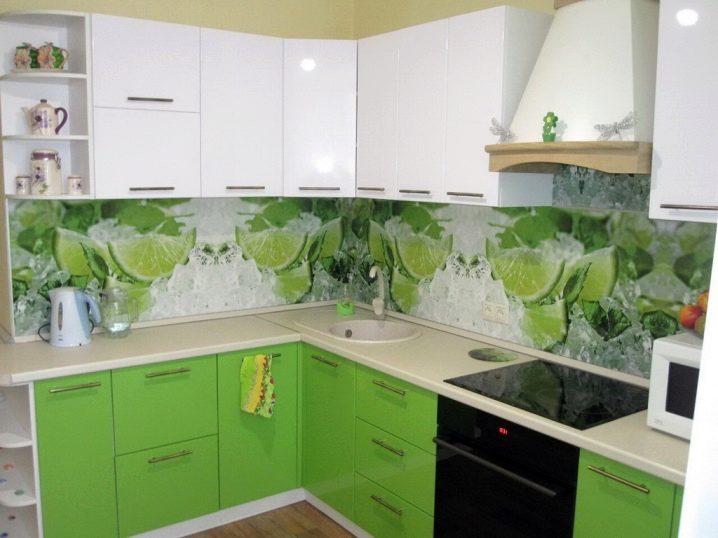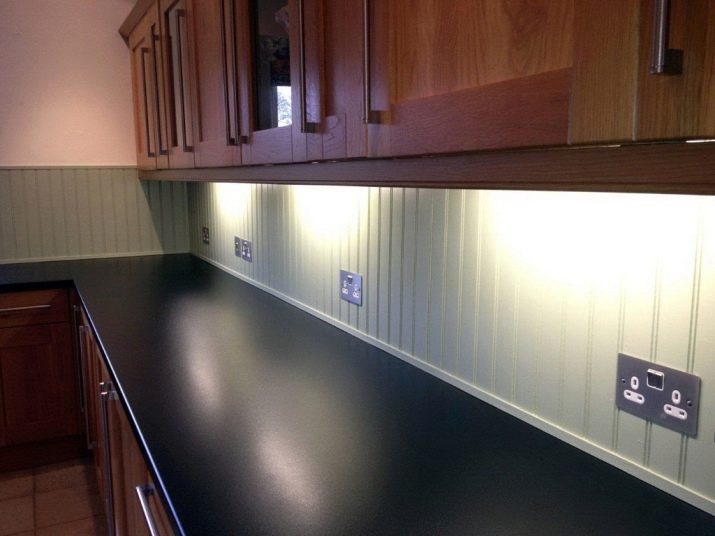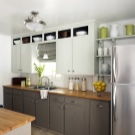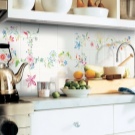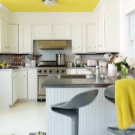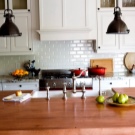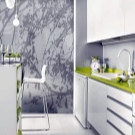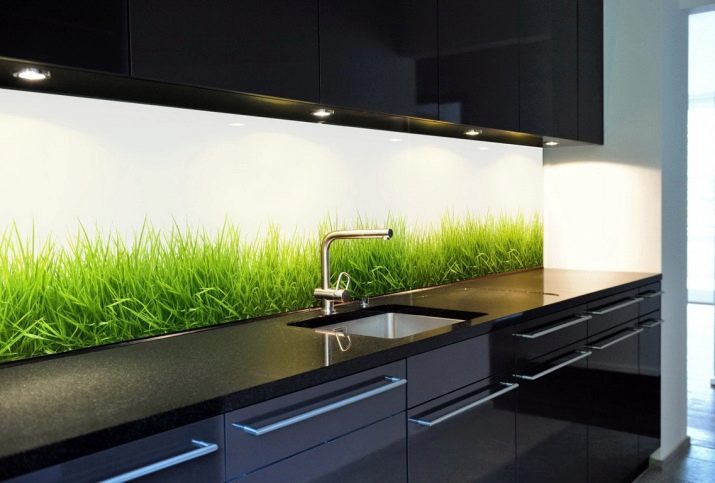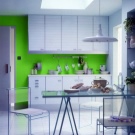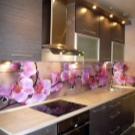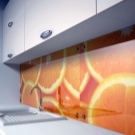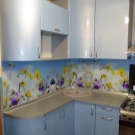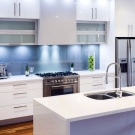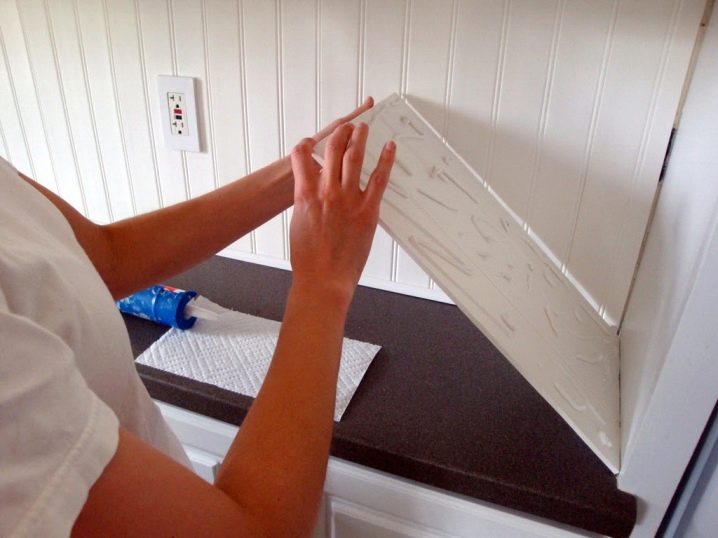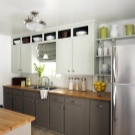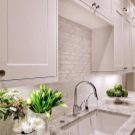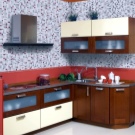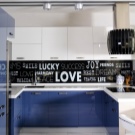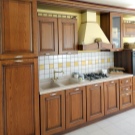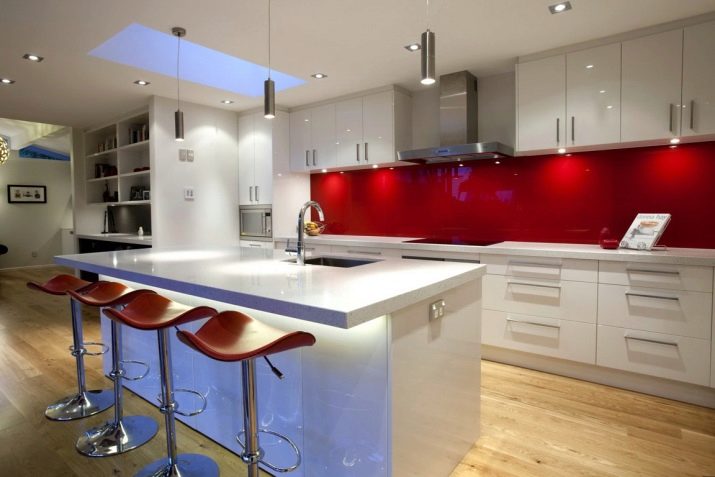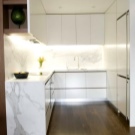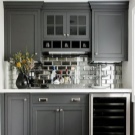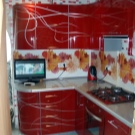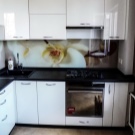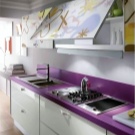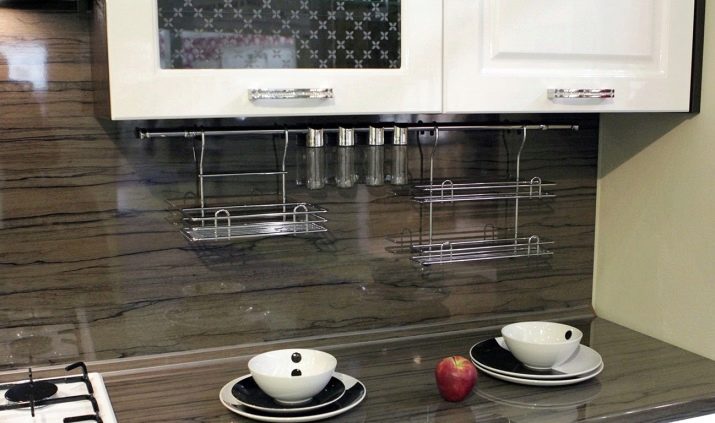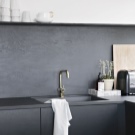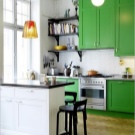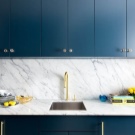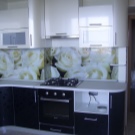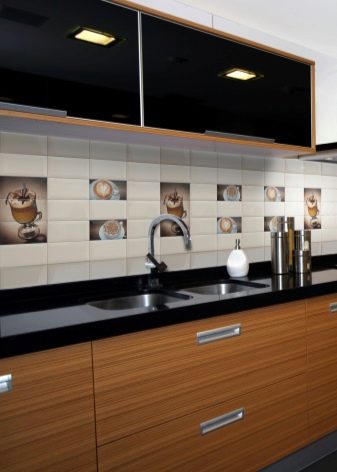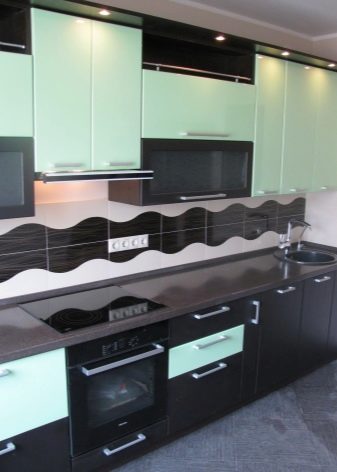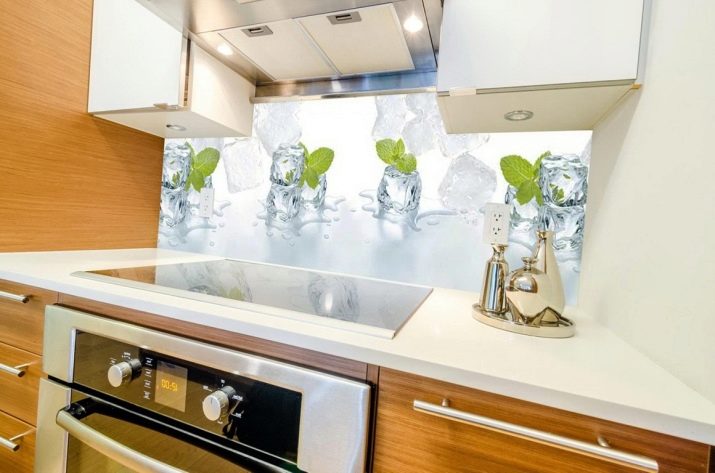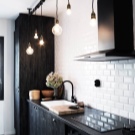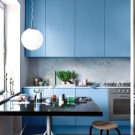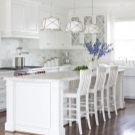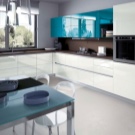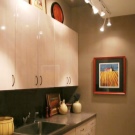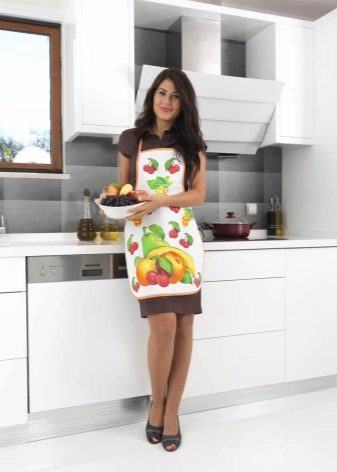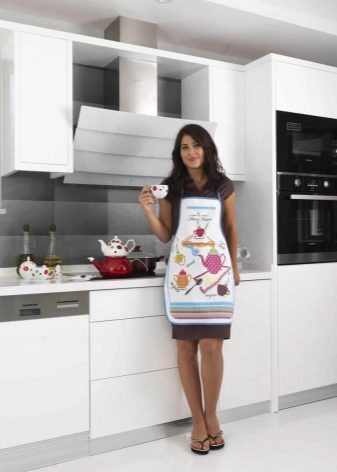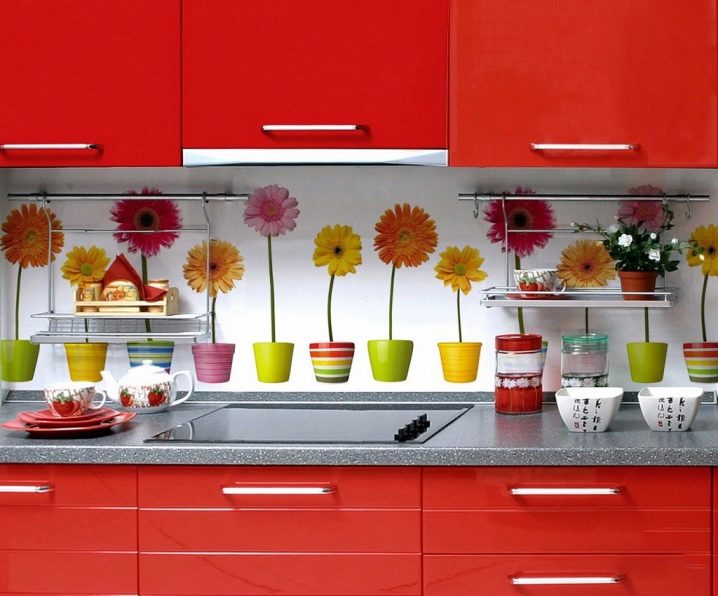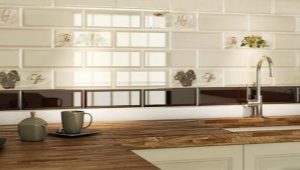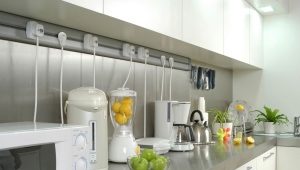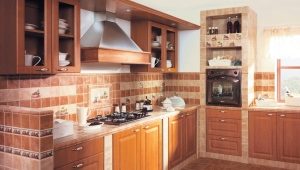PVC apron in the kitchen
What just does not fall to the share of the space between the table top and wall cabinets: splashes, dust, soot, and you need to look immaculately in the kitchen of a good housewife. Aprons made of PVC-panels correspond to this mission as much as possible.
Advantages and disadvantages
Undeniable advantages:
- beautiful appearance: the variety of textures and drawings allows you to fit into almost any style or its imitation;
- ease of installation: with little effort you can replace a boring apron with a new one;
- availability: on PVC the most affordable prices;
- convenience in operation: all types of dirt are easily removed from the smooth surface;
- absolute moisture resistance, absence of seams or barely noticeable joints make it possible not to worry about the appearance of fungus or mold;
- high level of heat and sound insulation.
But there are also disadvantages:
- additional protection is required in the zone of the slab (usually overlapped with refractory glass or metal);
- traces of dried water remain visible on a monochromatic surface, plastic loses its appearance under the influence of acetone, abrasive cleaners and brushes;
- scratches appear over time;
- loses in appearance and properties of natural materials.
Plastic can imitate a stone, wood, metal, on its surface a print or 3D image can be applied. Panels are easily cut, drilled, they produce neat holes for spot lighting and electrical outlets. For such an apron, you can hide communications, and from the front side fix light shelves or containers for spices.
PVC stability at + 120С seems sufficient to protect against heat effects of the cooker. But! If water begins to boil at 100 ° C, then the pan during the frying process can heat up to 400 ° C. That is, ordinary cooking drops of fat can deform the surface of a plastic apron.
The service life of PVC panels from 5 to 10 years. The most durable products are with high resistance to fire and abrasion. However, depending on the manufacturer, the properties and quality of materials may vary.Therefore, when buying, you need to pay attention to the guaranteed performance and quality certificate.
NATURAL SELECTION
Only after the creation of the entire interior project, it is time to choose an apron. The range of PVC panels is very wide and makes it possible to find a solution that will be harmoniously combined with the general style: wall cladding, a suite and work space. An error in the choice of properties, quality, color can lead to alteration or the kitchen for a long time will cease to please with its appearance.
Judging by the reviews on social forums, all types of PVC panels are used for the apron. Experience shows that plastic should be chosen with greater density and thickness, because the load and the impact of the environment on them in this area increases significantly:
- Rack panels. Width - from 25 to 50 cm, length - from 2.6 to 3 meters, up to 25 mm.
- PVC tile. Face sizes from 30 to 98 cm, thickness up to 25 mm.
- Sheet panel. The average size of the canvas - 1.22x2.44 m, thickness from 3 to 6 mm. The leader among plastic aprons.
PVC top decorative layer for the apron is also important. Of the three possible, the test of water and fire passed only two kinds.
Thermofilm, with which you can simulate images and textures of any surfaces, looks attractive. In terms of palette and variety of patterns, it surpasses tiled competitors. But because of its sensitivity to abrasive detergents, this is a choice for kitchens that do not enjoy cooking. Use a thermal film on the tile and sheet panels.
Lamination provides the maximum strength that plastic is capable of. Wear resistance increases many times and you can not restrain yourself in the selection of means for his care. With the help of lamination applied 3D drawings, photos of large sizes, without loss of image quality.
Today, on an apron, you can place your own image. In this case, the source should be of good quality and in high resolution, comparable to the requirements for printing photo wallpapers.
INVISIBLE OR CHICKEN ON THE CAKE
The gamma of the apron is chosen by comparing it with the color samples of the facade, table top, wallpaper and even the floor covering.
Small kitchen. For small spaces, designers recommend light-colored aprons. An ornament or photo should blend in with the overall tone of the headset.This will add light and visually increase the volume of the room. Successfully cope with the same task glossy, under the metal and mirror surfaces.
You can dress up an apron in a white or monochrome kitchen - rich colors are ideal for this role, but in small rooms it is better to choose a print or pattern that is not large. In the spacious kitchens are relevant and macro.
Under the color set. In this case, you should consider the colors and texture of all surfaces of the kitchen, including the dining area. Even textiles and decorative details of medium size are taken into account. A simple solution is an apron that matches in color with the largest surfaces in the kitchen or in the color of the headset, but in lighter or darker colors.
Options for basic solutions:
- In the color of the walls of the apron is chosen when creating an interior in soft pastel colors, or sets and walls in different colors.
- Under the countertop and flooring. Getting into one range of these three elements is widely used in the style of minimalism. Requires in support of a small number of bright and stylish items (coffee maker, electric kettle, etc.)
- In tone fronts or countertops. These solutions may exist in different versions.When assembling an apron from different structural elements, the facades and the accent part of the apron will be well combined with each other, if the tone of the rest of the apron walls remains neutral. A similar combination technique when a bright apron in the zone of the plate or at the sink is decorated with an ornament. Looks best with a linear and U-shaped kitchen layout.
- A bright apron that is not associated with the color of the overall interior, it is necessary to support the color allies: ornament on the curtains, vase, tablecloth. They can be upholstered chair, rug or kettle. But do not abuse and spray decorative additions throughout the space, there will be a feeling of confusion, untidiness.
CROW LINE
The width of the apron is usually limited by the parameters of the wall, sometimes the edge of the headset. For perfectionists, in order to provide the perfect line, in this case it is worthwhile to consider the dimensions of the edging profile. In the case of the calculation for the corner kitchen is considered the allowance for the joint.
The height of the apron is affected by:
- The distance between the wall and floor cabinets (usually does not exceed 112 cm) plus the allowance, which should provide a spade for the table top by 1-3 cm.The upper edge of the apron can be above the base of the wall cabinet, butt or below. In the latter case, the space between the sheet and the wall at the final stage of installation is filled with sealant, and the ends should be molded;
- the location of the hood (apron must be higher);
- open spaces of the upper tier under hinged shelves (depending on the kitchen project)
In the case of slats and tiles, the total area of the material needed is calculated. For a sheet panel, a drawing is required with the designation of the place, shape and diameter of the holes for laying pipes or installing electrical outlets. Dimensions should be convenient during transportation and delivery of the future apron up to the wall on which it will be mounted. Therefore, it does not hurt to check the possibilities of doorways and, if necessary, adjust the project.
APRON TO THE WALL
Before starting work, plastic is allowed to rest for several days. PVC is a thermo-dependent polymer, that is, when the temperature drops, the plates expand or contract. Acclimatization will allow to accept the sizes corresponding to future operation. This property should be envisaged during installation: the width of the walls and at the joints leftsmall gaps in 5-10 mm.
Installation does not differ from the options for wall cladding with PVC panels, does not require special skills. How to install an apron - is selected depending on the degree of curvature of the wall and possible temperature differences.
Using glue, applying it on a flat wall and sheet panels with strips every 15 cm, on the slats and PVC tiles in a continuous layer or point. After which the plate with a small effort pressed against the wall. Experts insist on using brands of blends designed specifically for PVC, otherwise the result will be unpredictable. When the temperature fluctuates at 25 ° C, this method is not recommended. Dismantling causes difficulties: it is difficult to preserve the integrity of the plastic, the glue is hard to remove from the wall.
With the help of screws. To do this, in advance, at the edges and corners of the sheet panels, drill holes with a diameter of 3-5 mm, and then fix the apron through them with screws to the wall. Hats are hidden under caps and caps.
The method is convenient for dismantling during the repair of communications.
With the help of screws to the crate. A wall with small irregularities will require the installation of a frame of metal, wood or plastic profiles.
For the rack - the average intermediate interval - 15 cm.
For sheet - you can do without internal partitions.
Additional reinforcement structures are provided in places where hinged shelves are planned to be located; spice containers are capable of withstanding dense plastic itself. Then pave the communication, LED or fluorescent lighting, controllers, etc., always in a protective sheath.
Rack plates are assembled with the help of grooves, self-tapping screws are screwed into them, which fix the plastic lining to the frame. With horizontal installation, the docking groove must be directed downwards, this will prevent moisture penetration under the finishing material.
Sheet panels are checked for matching holes and sockets. Focusing on the crate at the edges and corners, drill holes and fix them with screws through them.
With glue to the crate. A frame is constructed and an apron is glued to it. Glue is applied to the contact elements and mounting structure, and plastic. The surface of the parts should be smooth and smooth.
For rooms where there is a possibility of condensation on the walls,professionals advise top and bottom of the apron frame to leave gaps about 7 mm wide for natural air circulation. This technique is relevant for owners of country houses.
